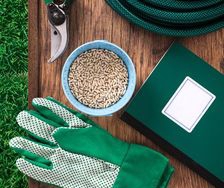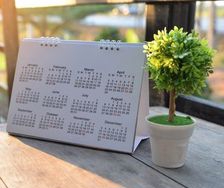Yates Account
Join now
Create a Yates account today!
Sign up to join the Yates Garden Club for monthly e-mails packed with seasonal inspiration, tips for success & exclusive promotions.
Plus if you’re a Garden Club member you can take part in the Yates Growing Community - a blog to share successes, get advice & win prizes in fun challenges along the way!

Forgot password
Enter the email address associated with your account, and we'll email you a new password.

What to do, this Month
April is another busy month in the garden, as the remnants of summer finally disappear. The timing is perfect to get new plants settled into warm soil. You can squeeze in a seasonal tidy-up in comfortable temperatures, before the chilly weather encroaches to make it an unpleasant task. Differences between North and South will become more apparent in mid-autumn; cold conditions race in much faster in the South, whereas the North might be able to eke out the last of the warm weather for a little longer.
- As your plants slow down, it's a great time to start a landscape project. Got a small job to fix something? Get into it before the weather turns. Even if you're planning a major overhaul, this month is ideal - it's not too hot to dig, and the soil won't be rock-solid.
- Before the weather turns unpleasant, make time for a backyard clean up. Store away summer furniture to help it last longer, give fences, paths, and pots a scrub, sort out the shed, and clean and sharpen your tools.
- Watch the weather forecast to gauge the risk of frost - make a plan to protect your tender plants.
- The weeds will begin to take advantage of the cooler, damper environment. Take care of them now before they get a chance to establish, as they'll be more difficult to remove by spring.
- Warm, damp autumnal conditions are ideal for slugs and snails. Take precautions to protect your seedlings and plants. Lightly scattering bait around each plant (following the directions on the box) will keep precious plants safe.
- Wait for a decent downpour that penetrates deep into the earth, then apply mulch to lock out weeds and insulate the soil from the winter chill.
- Avoid placing mulch so that it's touching tree trunks; leave an air gap between mulch and trunk to discourage diseases.
- An organic mulch will break down over time, improving the soil consistency and rejuvenating the microbial soil communities.
- Give wildlife a helping hand by setting up bird feeders, and leave some seed heads on spent plants for birds.

Trees and Shrubs
- April is the best time to decide on trees and shrubs to add to your garden for seasonal interest. Wander through your neighbourhood, local botanic gardens, and garden centres to see the magnificent autumnal colours and select your favourite.
- Planting trees and shrubs now will give them a chance to establish before growth slows in the cool of winter. Give new trees fertiliser to encourage strong growth and support stakes to prevent root rock during windy conditions. Continue to water well for the first year.
- Feed existing trees and shrubs to help them to prepare for the harsh winter conditions ahead.
- It is the last chance to prune trees and shrubs and trim hedges where any new growth would be damaged by cold weather and frost.
- As leaves begin to fall, remove them from the lawn and paths, but allow them to remain in garden beds as a mulch and safe place for wildlife to overwinter.
Vegie Tasks
- Keep sowing beetroot, broccoli, broad beans, Brussels sprouts, cabbage, cauliflower, carrots, radish, silverbeet, spinach, swedes, and turnips for a winter harvest.
- If garden beds are prone to flooding, plant crops on a raised ridge of soil, or grow them in containers.
- Potatoes can be planted in frost free areas.
- 'Blanch' leeks by mounding up the earth around them, to get the desirable long white stems.
- Before replanting the garden with winter crops, enrich the soil with compost and organic material. This replaces the nutrients that were exhausted by summer crops.
- Sow a green manure such as mustard or lupin, into empty beds to protect and improve the soil.
- Harvest the last of the pumpkins once the leaves have died back and the stalk goes brown and corky. Leave them in a sunny dry spot to cure and sweeten, then store in a cool dry place.
- Keep picking late summer vegetables, as long as they continue to provide a harvest. Regularly liquid feed to sustain tired plants. Keep an eye out for frosts that will put an end to the late season abundance.
- Peas and lettuce prefer the cool weather, so make the most of salads and sweet tender peas this autumn.
- Dig up kumara when the leaves go yellow or before the first frost. Leave in a warm sunny place to cure the kumara before storing them.
- Protect brassica plants from the Cabbage White Butterfly with butterfly netting, or with Yates Success Ultra Insect Control or Derris Dust. Check your plants frequently - pick off caterpillars and eggs from under the leaves of small seedlings.

Fruit Trees and Berries
- Once your fruit harvest has finished, you can begin the winter clean-up of your trees by removing any windfall fruit from beneath them. If trees were struck by pests or disease this season, don’t add fallen fruit to the compost.
- Once the leaves have fallen you can begin spraying with a fungicide to control diseases, including peach leaf curl in stone fruit, brown rot, and scab.
- Gather ripe feijoa as they fall to the ground.
- At this time of year, codling moth larvae will be making their way from apple trees into the soil underneath them, to pupate. Interrupt the lifecycle by spraying or removing them.
- Citrus will be putting on a lot of growth at this time of year and will welcome a citrus fertiliser boost. Thin out large clusters of fruit for a better, healthier harvest.
- Overcrowded rhubarb can be divided and replanted into soil enriched with compost and organic material.
Flowers Everywhere
- Tidy up summer annuals as the plants become tired and scraggly. Give the soil a pick me up with compost and a general fertiliser and plant winter annuals such as pansies, primulas, polyanthus, stock, and antirrhinums to continue with a bright and cheerful display over the coming months.
- Move containers to a more sheltered spot if the plants are at risk from harsh winter conditions.
- For an affordable way to grow masses of colour for your garden, sow seeds for aquilegia, alyssum, calendula, cineraria, cornflower, dianthus, English daisy, godetia, hollyhock, linaria, Livingstone daisy, lobelia, lupin, nemesia, poppies, statice, stock, sweet pea, and viola.
- Give yourself something to look forward to by planting spring flowering bulbs for a magnificent display to signal the start of the new growing season.
- Create a tradition of sowing Flanders Poppy Seeds on the 25th of April to commemorate ANZAC Day.
- Lift and divide overcrowded perennial plants for free plants to spread around your garden or to give to friends.
- Dead head and tidy scraggly growth from flowering perennials including daylilies, phlox, scabiosa and echinacea as they wind up for the season.
- To save seeds from your favourite flowers, leave faded blooms and allow to set seed. Once the seeds are mature, harvest on a dry day and store in a dry place in a labelled paper bag.
- Leave the last rose blooms as they fade so they can develop into rosehips for a winter display.
- In areas with very cold winters or soggy soils, dig up dahlia tubers and gladioli corms once the foliage has died back and store in a cool, dry place until the spring.

Love Your Lawn
- There will be enough remaining warmth in the soil to successfully germinate grass seed. If you need to start a new lawn from scratch, it's a great time of year to do it. There's a seed for every situation, to get the ideal lawn for your needs.
- Existing lawns will benefit from an application of lawn fertiliser, to boost healthy growth as the season gets cooler.
- Rake the lawn to loosen the thatch buildup, which allows moisture to fully penetrate into the soil below.
- Now's a good time to even out lumps and bumps in the lawn and make any necessary repairs.
- Keep up with weeding out broadleaf weeds in the lawn. Spraying is the most effective option if the weeds have gotten away on you!. Remember to wear your gloves and mask, follow the instructions, and avoid spraying if rain is on the way.
- The change of season creates ideal conditions for fungal diseases and insect pests to take advantage of a tired lawn. Keep an eye out for brown patch, fusarium, dollar spot and anthracnose and tackle them quickly with Yates Fungus Fighter Fungicide. Insect infestations like grass grub or porina can be treated with Yates Lawn Grub & Porina Kill + Protect.
















Share
Share this article on social media